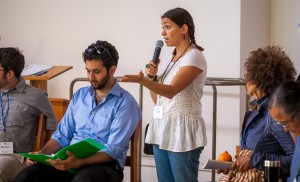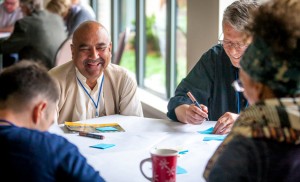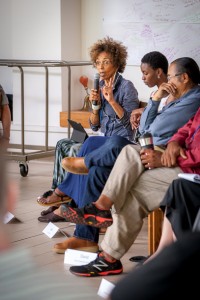A three-year project to envision and map a positive future for restorative justice began in mid-2015 with a five-day meeting of 36 people drawn from a wide range of backgrounds by the Zehr Institute for Restorative Justice at Eastern Mennonite University (EMU).
“We sought to bring together a cross-section of restorative justice practitioners, theorists and innovators,” said Carl Stauffer, co-director of the Zehr Institute and the project’s leader. “Some of the invitees were world-recognized in the restorative justice field, but others were invited to ensure that diverse and often-unheard voices would be represented.”
One-third of the 36 participants were from populations that are under threat socially and economically in their regions of the world. The genders were equally represented. One person was under age 21, though two other young adults had been expected to attend.
Conversing about RJ’s ‘revolutionary intent’

The idea behind the unusual mixture of invitees was to foster provocative conversation about the possibilities for restorative justice (RJ), particularly for addressing structural injustices, said Stauffer.
In the prospectus for the three-year project submitted to the funder, Porticus, the organizers wrote: “On the social margins, there is growing research and experimentation with RJ as a tool for addressing structural harms and injustices. This project will explore and document these emerging practices in order to recapture the revolutionary intent of RJ.”
The organizers called attention in their prospectus to what they viewed as the danger of RJ settling into a “social service practice” centering on “repair at the micro-interpersonal level.” Instead, they wished to highlight the ways that RJ can “provide a coherent framework for transforming macro-social structures that cause harm.”
Aware that many of the 36 attendees at the first consultation would not have prior relationships with each other, the organizers devoted about half of the five days to exercises and facilitated conversations designed to establish trust and a common basis for exploring future possibilities. Senior graduate students at EMU’s Center for Justice and Peacebuilding served as facilitators for the process.
Tough questions

First, the attendees prepared a history line of RJ, then they explored identity, power and privilege in the field. On the third day, they embarked on a discussion of best practices.
“We accepted the challenge of bringing together a highly diverse group, especially given that many of the participants are international leaders in the field, [being] accomplished researchers, authors, practitioners and facilitators in their own right,” Stauffer said.
“The challenge was heightened because the group grew beyond the original envisioned size of 20 to 25,” he added. “We needed to go well beyond 25 to have a true cross-section of voices, but it was difficult to develop coherence among three dozen people with strong opinions, especially in only five days.”
Yet the participants were largely positive in their final evaluations, he said, indicating that they had not regretted investing a workweek in wrestling with each other over tough questions, such as the extent to which RJ should be viewed as a social movement, as opposed to simply a set of restorative practices.
Stauffer did not pretend to be neutral on this last point. In his opening remarks to the group, he referred to the U.S. penal reform movement having been “co-opted.” In contrast, he said he hopes RJ continues to grow into a social movement in North America, with the aim of “transforming deep structural conflicts and injustices.” Toward this end, North Americans have much to learn from their international brothers and sisters about “large-scale applications” of RJ, he said.
Agreement on RJ’s core values

For a social movement to be successful, Stauffer told the group, it requires political opportunity, resource mobilization, a framing message, and critical mass (or a “tipping point”).
On the last day, in a final small-group presentation, a participant observed that the 36 attendees had largely agreed during the week on RJ’s core values, but not necessarily on how to practice restorative justice.
This first consultation will be followed next year by a public conference attended by up to 120 people. Next time, Stauffer said, his organizing team will work to create a conference format that moves participants more quickly into discussions on the future of the field, with a view of moving into a research and writing phase in the final year of the project.
Participants in the consultation
The 36 participants were:
- Aaron Lyons, Fraser Region Community, Justice Initiatives, Canada
- Ali Gohar, Just Peace Initiatives, Pakistan
- Barb Toews, University of Washington Tacoma / Designing Justice+Designing Spaces, USA
- Barry Hart, Center for Justice and Peacebuilding, EMU
- Brenda E. Morrison, Centre for Restorative Justice, Simon Fraser University, USA
- Carl Stauffer, Center for Justice and Peacebuilding, EMU
- Carolyn Boyes-Watson, Center for Restorative Justice, Suffolk University, USA
- Catherine Bargen, Restorative Justice Coordinator Crime Prevention and Victim Services Division, Government of British Columbia, Canada
- Dan Van Ness, Center for Justice and Reconciliation, Prison Fellowship International, USA

From left: Fania Davis, Jodie Geddes, Justice Robert Yazzie. - David Anderson Hooker, Center for Justice and Peacebuilding, EMU and Atlanta (Ga.) consultant, USA
- Fania Davis, executive director of Restorative Justice for Oakland (Calif.) Youth, USA
- Cameron Simmons, youth worker with Restorative Justice for Oakland (Calif.) Youth, USA
- Gerry Johnstone, University of Hull, UK
- Howard Zehr, Center for Justice and Peacebuilding, EMU
- Jeanette Martinez, Circle of Justice LLC, New Mexico, USA
- Jennifer Graville , Community Conferencing Program, KBF Center for Conflict Resolution (Md.), USA
- Jodie-Ann (Jodie) Geddes, Center for Justice and Peacebuilding, EMU
- Josh Bacon, James Madison University (Va.), USA
- Kathy Evans, Eastern Mennonite University
- Katia Ornelas, Independent Consultant, Mexico
- Katie Mansfield, Strategies for Trauma Awareness and Resilience (STAR), EMU
- Kay Pranis, Circle Trainer, USA
- Kim Workman, Stout Research Centre for New Zealand Studies, Victoria, University of Wellington, New Zealand
- Linda Kligman, Vice President for Advancement, International Institute for Restorative Practices, USA
- Lorenn Walker, Hawai’i Friends of Restorative Justice, USA
- Lorraine Stutzman Amstutz, Mennonite Central Committee, USA
- Mark Umbreit, Center for Restorative Justice & Peacemaking, University of Minnesota, School of Social Work, USA
- Matthew Hartman, Clackamas County Juvenile Department, Restorative Justice Coalition of Oregon, NW Justice Forum, USA
- Mulanda Jimmy Juma, Africa Peacebuilding Institute, St. Augustine College of South Africa
- Najla El Mangoush, Center for Justice and Peacebuilding, EMU
- Robert Yazzie, Chief Justice Emeritus of the Navajo Nation, USA
- Seth Lennon Weiner, Porticus, New York, USA
- sujatha baliga, Impact Justice, USA
- Susan Sharpe, Advisor on Restorative Justice, Center for Social Concerns, University of Notre Dame, USA
- Theo Gavrielides, The IARS International Institute and the Restorative Justice for All Institute, UK
- Vernon Jantzi, Strategies for Trauma Awareness and Resilience (STAR), EMU
The facilitators were led by project manager Soula Pefkaros, and included CJP graduate students Janine Aberg, South Africa; Michael McAndrew, USA; Jordan Michelson, USA; Mikhala Lantz-Simmons, USA; and Ahmed Tarik, Iraq.

Maximizing the revolutionary potential of Restorative Justice will not be possible until its relationship with the concept of peace is mutually defined and agreed upon. In order to do so, the international community must settle on what is restored, to whom, and how?
In 1996-97 I was Secretary of the UN Working Party on Restorative Justice. Once I had determined to my own satisfaction the answer to the above question, I left that position, plus my position in Vermont’s new Restorative Justice programming, and founded the Campaign for Equity-Restorative Justice (CERJ) as an international consortium of practitioners, theorists, trainers, analysts, and commentators dedicated to pursuing Restorative Justice from a more radical perspective.
Some seven years and tens of thousands of articles, correspondence, etc., went by, and we finally reached clearness on re-naming our consortium John Woolman College of Active Peace. You can ask John Braithwaite about this … he was part of it. Our work culminated with an innovative PACT workshop at the United States Maximum Security Prison at Leavenworth, Kansas. Robert Yazzie was one of the lead trainers at that event, where 40 prisoners were trained in the AVP (Alternatives to Violence) method, in Restorative Justice, and in traditional Dineh (Navajo) peacemaking. Ironically, this training was funded by the George W. Bush White House Office of Faith-Based Initiatives.
In more recent years I have reached clearness on some other theoretical statements about Restorative Justice which are designed to eliminate confusion on some of the terms we use. One of the biggest problems is that, after Lederach began to use it wrong, many people refer to Restorative Justice as “peacebuilding”. It is not — it is a sub-set of peacemaking, which is also known as conflict transformation. The other huge conceptual problem is the use of the term “conflict resolution” but we seem to gradually be getting away from that.
Please reference my article ‘Justice as Active Peace’ in the June, 2012 issue of Contemporary Justice Review, the journal of the Justice Studies Association. Also please read the further theoretical statement below, on the five stages of development toward Active Peace. I am currently working on some practical Restorative Justice oriented workshop approaches for white people to work among themselves in eliminating the roots and causes of racism, also incorporating some techniques of Theater of the Oppressed.
Many kinds regards,
John Wilmerding
former Secretary (1996-97)
United Nations Working Party on Restorative Justice
Excerpted from the forum Peace and Collaborative Development (2009):
Presented here, for comment and discussion, are the five developmental stages toward Active Peace.
[0. ‘Surface’ — conformity without question. Unconsciousness, unawareness, denial, or opposition to issues of social conscience involving violence, oppression, subjugation.]
1. ‘Aquiescence’ — You know there is something wrong, but take no action, or it doesn’t affect how you live your life. Your response is to remain ‘quiet’ to others and within yourself. “Things have always been this way … there is nothing that I or anyone else can do to change them.”
2. ‘Pacifism’ — You are no longer quiet within yourself. Your discomfiture with violence, oppression, etc. begins to affect how you live your life. You might turn the other cheek in a fight, for example. You are likely to witness to others (and to yourself) that organized violence and oppression is wrong.
3. ‘Passive Nonviolent Resistance’ — Many or all of your private decisions become influenced or governed by conscience. ‘Conscientious objection’. You make changes in your own behavior by reasons of conscience but are not necessarily social about it, or don’t publicly, systematically cite your actions or your reasons for them. It’s also akin to the concept of ‘standing aside’ or of ‘abstaining’ on a vote.
4. ‘Active Nonviolent Resistance’ — You take social leadership in attempting to thwart the forces of violence, oppression, and subjugation, or join with others who do, publicly, and attempting to spread the word about the initiative and get others to take part. ‘Standing In The Way’.
5. The triad of ‘Active Peace’:
5A. ‘Peacemaking’ — the transformation of conflicts away from violence, oppression, and subjugation by social and political means. Mediation, conferencing, circles peacemaking, and kindred ‘encounter’ forms. ‘Workshop’ methods such as AVP can also be effective. There are hybrid forms (encounter/workshop) such as HROC, a spinoff of AVP in Rwanda.
5B. ‘Peacekeeping’ — Nonviolent Accompaniment. Need not be organized or public in its motivations, but is more effective when it is done publicly, and the reasons are publicized. [Not what the UN does with guns and uniforms, though they call it that.] Most well-know exemplars are Nonviolent Peaceforce, the proposed Canadian Civilian Peace Service, Christian Peacemaker Teams, Muslim Peacemaker Teams. “Why are the missiles called peacekeepers when they’re aimed to kill?” — Tracy Chapman
5C. ‘Peacebuilding’ — Sustainable Development — providing for human needs so that the associated conflicts involving sustaining life (land, water, food, health care, etc.) are ameliorated or eliminated. Fair Trade as opposed to ‘”free trade”. Local economic initiatives. Local alternative currencies. Barter economies. ‘Organic’ agriculture. Methods of redistribution of wealth, including economic stimuli, may be useful on the way to more synergistic outcomes where the weal is more naturally held and distributed in common.
One interesting aspect of the five-stages theory seems to be that the next one only becomes visible or understandable to you once you have attained the one before. In this way, each stage represents a ‘perspective’, both individual and social, and social ‘organisms’ can be said to progress through the stages as well as individual ones.
Another dynamic is that, for various psychological reasons I won’t go into here, people or social groups can vary in how they move through the stages, and sometimes regress. However, my understanding is that one one has a firm purchase on a stage, retrogression becomes much more unlikely. Human beings and social organizations are very complex, however, so there is still much more to learn about how to bring everyone into higher stages. Education about these things is both inevitable and necessary.
Of the five stages, only Active Peace — stage V — can accurately be interpreted as ‘the ocean of light flowing over the ocean of darkness.’
Congratulations and acknowledgements go out to Gray Cox for first writing about Active Peace, and to Johan Galtung for his work in refining the development of the triadic theory — peacemaking, peacekeeping, peacebuilding. Thanks also to our colleague Howard Richards for his conceptual and theoretical treatise on Peacemaking, and his many other wonderful writings.
Incidentally, many peace studies and conflict transformation programs throughout the world use these ‘triadic’ terms interchangably, and therefore inaccurately and misleadingly. Of those who do, the ones most likely to do so are those influenced by governmental or corporatist entities and agents.
It is crucial that these terminologies be used accurately and consistently in order that humanity as a whole might progress toward Active Peace — or alternatively (as some see it) recover Active Peace as our natural state.
Thanks, John, for taking the time to offer your interesting and thought-provoking perspective on the past, present and future of RJ in relation to peacemaking. Here at EMU’s Center for Justice and Peacebuilding, we have not chosen to embrace the terms and definitions of what you call “Active Peace.” Indeed we have our own ways of employing the terms “peacebuilding” and “conflict transformation,” and we trust that our 20-year history of popularizing and using such terms speaks for itself without our debating whether your preferred definitions or ours are the best. In short, may we all let our work speak. Thank you for your decades of work on behalf of Active Peace.